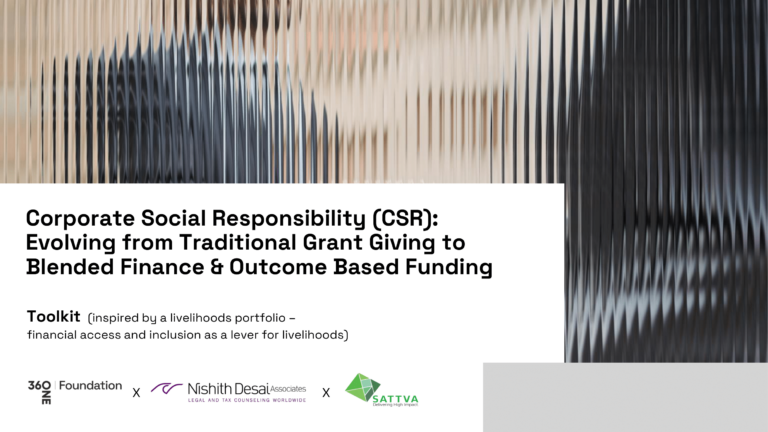Srikrishna Sridhar Murthy
28 November, 2022
The CSR law in India has seen not only an increase in corporate giving but development in the strategic deployment of that giving
It has been seven years since a corporate social responsibility (CSR) law was implemented in India. The passage of time has led both corporates and observers to ask, ‘What difference has it made?’.
Let’s rewind a bit. In the first few years since the law came into existence – call this period CSR 1.0 – the focus for companies was primarily on ensuring compliance. CSR spending tackled specific issues or community needs, anchored around a company’s business goals. According to the Ministry of Corporate Affairs website CSR funding has increased by 85 per cent since 2014-15 and the number of companies reporting the data was up by 50 per cent. Over 40 per cent of companies reporting CSR incurred the expenses themselves, through in-house implementation or through their own trusts or societies or Section 8 companies. Another change we’ve seen is that the share of companies spending more than their prescribed amount has been increasing – from 10 per cent in 2014-15, to 31 per cent in 2019-20. So, there was a lot to cheer about how well corporates and philanthropy had come together to embrace the law and focus on impact on the ground. And yet, despite widespread adoption and mobilisation of philanthropic capital, the efforts were mostly around ‘projects’ and ‘CSR compliance’.
And then the pandemic hit. The ensuing business disruptions led to widespread introspection, resulting in a far more strategic view of impact. The focus noticeably shifted from ‘response’ to ‘responsibility’. So while CSR was evolving into a 2.0 version already, the Covid-19 pandemic accelerated it.
From response to responsibility
Although CSR efforts continued to be closely aligned with corporate goals and strategies, it was a time to leverage collaborations, mutually beneficial partnerships, and other corporate competencies such as tech and data. A key outcome of this period was the prevalence of long-term strategic perspectives that involved building greater resilience to withstand disruptions that could undo previous efforts, such as we saw with the pandemic.
Here are some of the main ways in which corporates have shifted their CSR strategies from a compliance to a problem-solving perspective:
- Leveraging in-house talent and expertise and adopting multi-dimensional approaches to solve problems that are aligned to business. For example, one of our corporate clients in the oil and fuel business chose to work on the welfare of truck drivers. This was a segment that they understood and were keen to help. Another great example comes from a reputable company known for its outstanding design ethos. They chose to pioneer Design Impact awards and grants for products designed for social good. Mentoring from their design and business leaders transformed how these products and organisations evolved.
- Focus on underserved geographies and issues – development of underserved geographies (such as the aspirational districts) through localised initiatives and programmes on specific issues such as malnutrition. Finding suitable partners for programme implementation and monitoring in these remote geographies involves great operational complexity. At Sattva, we work with a central government body in India on betterment of aspirational districts. Through the discussions we held with India Inc, some of large companies have chosen to focus on these underdeveloped districts now.
- Promoting research and innovation – scaling proven innovative social impact innovations through CSR to leapfrog solutions at scale. We have helped incubate over 130 start-ups through our five incubation partners that are premier education and research institutions in India, and we have seen first-hand how the corporate funding fuels the ambitions of these entrepreneurs.
- A focus on sustainability – the law enables clearer focus on sustainability through convergence of CSR and environmental, social and governance (ESG) in company portfolios.
- Collaborative approaches – more alignment with government machinery, collaboration with civil society organisations, partnerships with academic institutions as well as foundations and HNIs are all being adopted to scale impact. For example, we are closely involved with Life Skills Collaborative, Bharat EdTech Initiative and more, learning how collaboration among stakeholders is leading to systemic transformation in these areas.
- Data-backed decision-making – the corporate way of working as well as recent amendments to the CSR law have made the design, tracking and measurement of impact better, thereby adding rigour to governance.
I see the road ahead, therefore, as that of leveraging the full strength of corporate competencies and capabilities to give CSR efforts a strategic impetus.
In conclusion, the law and CSR itself have undergone a landmark change. It’s not CSR as usual anymore. Today, an increasing number of corporates are pushing the domain of CSR beyond compliance and are looking at resources beyond money to reap intangible benefits for their business, while at the same time associating their brand with critical social causes to amplify impact.
Here’s to CSR 3.0 – together towards a sustainable world of opportunity for all.




